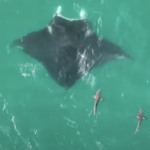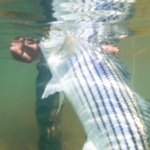
Veteran Florida Guides Concerned About False Albacore
While the ASGA team is extremely proud of the community we’re building with the Guide
On January 15, the Technical Committee at ASMFC reviewed conservation equivalency proposals from various states in preparation for the meeting scheduled on February 4, 2020.
As each state went through the proposals, it became fairly clear that the uncertainty surrounding the data was being exploited by some states to continue with unsustainable harvest.
ASGA has taken the position that conservation equivalency should not be allowed for a stock that is overfished and overfishing is occurring. Striped bass currently meet both these criteria.
Our position is based on the failure of previous CE efforts in Maryland. The current CE measures being proposed by several states are essentially manipulated data to circumvent the mandates of the Striped Bass Management Board.
It seems as though the TC agrees with us on some level. Below are quotes from the supplemental material distributed prior to the meeting next week. Maryland is using MRIP data with PSE’s higher that 25%, Furthermore, they are including about 10 days of a kill season (opening day in Maryland is normally the 3rd Saturday in April) to inflate the effort on the pre-season catch and release numbers. We are encouraged that this appeared in the documents.
The TC stresses that predicted savings from a “no targeting” provision are highly uncertain due to current data limitations. While the TC supports the use of closed seasons to reduce effort and discard mortality, determining a reasonable assumption to predict the level of savings that could be expected under a“no targeting” provision remains a challenge. Furthermore, the TC recommends the Board consider providing guidance for similar decisions in the future.
http://www.asmfc.org/files/Meetings/2020WinterMeeting/AtlStripedBassBoardSupplemental.pdf
The TC expanded on no targeting closures as well as New Jersey’s desire to kill small, immature fish (taking advantage of the robust 2015 year class). Again, we are pleased to see the TC commenting on this issue.
The TC maintains that there is a high level of uncertainty in the percent reductions calculated due to the effect of changes in angler behavior (effort) and the size structure and distribution of the population (availability of legal and sub-legal fish). These changes are difficult to account for and cannot be accurately quantified.
http://www.asmfc.org/files/Meetings/2020WinterMeeting/AtlStripedBassBoardSupplemental.pdf
Finally, ASMFC said we need to take an 18% reduction coastwide. That doesn’t translate into every state taking an 18% reduction. It sounds a little wonky but some states were going to have to take a larger cut and some states would take a smaller cut. At the meeting in October, a NJ commissioner threw a wrench into the 13, not 10, year recovery plan by saying each state should take an 18% reduction individually. Now, we can add the CE proposals to further increasing the likelihood of failure for striped bass recovery.
The predicted coastwide reduction in total removals may be different than 18% after accounting for conservation equivalency measures.The TC has not evaluated the expected impact of the combined management scenarios
http://www.asmfc.org/files/Meetings/2020WinterMeeting/AtlStripedBassBoardSupplemental.pdf
So, what can you do about this as an angler? We put our thinking caps on for this one. It is a situation where the numbers look good on paper. But, they are being questioned by the TC in the supplemental material. We probably won’t win if we fight CE head on.
However, we can still protect striped bass. We must demand paybacks and other accountability measures for states that overfish via CE in 2020. There is a long history of precedents for this in fisheries management. We also need to add up all the CE proposals and figure out if we are really going to hit the 18% coastwide reductions as outlined in the last quote from the meeting materials.
In regard to a payback provision, if the 2020 numbers come back and show one or two states using CE and not meeting the 18% reduction, they will have the overage deducted from their 2021 allotment. Makes perfect sense right?
How can anyone argue against this? If Maryland and New jersey truly believe that their plans will conserve fish, then this shouldn’t be an issue. If they are truly interested in being responsible to the coast, this just makes sense. If they fight against this solution, well…we have our answer.
Might be a good time to send your commissioners an email asking for payback provisions as well as some number crunching to ensure the 18% reduction is met.
Here is the contact info. Send polite, concise, and courteous emails no later than Monday. http://www.asmfc.org/about-us/commissioners

While the ASGA team is extremely proud of the community we’re building with the Guide

Feature Image: A false albacore being landed off Jupiter Florida by the Cheeky Fishing team,

Feature Photo: “Best Practices for Fishing Cobia Around Manta Rays” The Florida Manta Project is

We caught this article a few days ago. Here’s the summary: Maryland striped bass commercial
We rely on our members and donations to keep fighting for a sustainable tomorrow in marine conservation.
By using this website, you agree to our use of cookies. We use cookies to provide you with a great experience and to help our website run effectively. To learn more, please review our privacy policy.
11 Responses
CE are being used the wrong way and should not be allowed. Hopefully the striped bass regulations are handled as an entire entity and not cater to individual states like MD and NJ who want to harvest more fish, trophy tags, bonus tags, etc.
I don’t see how they think this is the answer for one thing the 13 year plan is too broad and it allows further damage to the striped bass population it’s too long of a period I would rather seek a 5 year plan as this would allow us to make immediate changes that would have more benefits for the fish sec
ond the reduction needs to be
the same across the board with minimum size and limit anything less can only be considered big money talking with no end result other than more depleted stocks I know this is a separate issue but we have to get rid of the gill nets and barbed hooks both do irreparable damage
The TC admitting it doesn’t have a clue about recreational data accuracy and it’s use in managing the fishery should be the issue that is contested. Numbers are worthless unless accountability is in place to verify actions taken result in the needed consequences. The ASMFC is whistling past the graveyard on the recreational ( 90% of mortality) issue. Recreational individual fish tags creates the accountability needed to manage this fishery. It works on the commercial side to provide accountability and would do the same on the recreational side.
We’ve got deep problems with misrepresentation of recreational anglers by the regional hire and tackle sectors, and nobody from the larger tackle industry players wanting to get involved.
I was recently told the best estimate of the striped bass rebuilding time frame was 13 years.
Very hard to send them a letter and being polite about it
The States can not be trusted to do the right thing. They are ruled by greed. It is time the Federal government step in and take over the management of Striped Bass stocks, under inter State commerce laws. Game fish status till stocks return or moratorium .
More rockfish than it’s ever been. Learn to fish and shut up
Ok, you are right. We quit. Thanks for showing us the light. You should run for Governor. Compelling orator, firm grasp on the English language, and willing to work with others for a brighter future. Triple threat!
You’ve got to be kidding, right!? With that grasp of facts, you should run as a GOP Senator.